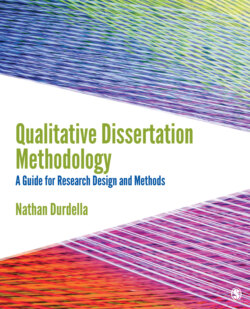Читать книгу Qualitative Dissertation Methodology - Nathan Durdella - Страница 60
На сайте Литреса книга снята с продажи.
Resistance to changes in conventional dissertation research structure.
ОглавлениеWhile newer formats and processes of dissertation research have emerged as alternatives to traditional dissertation writing and research production, the academy has been generally resistant to change. The evidence: conventional dissertations in the book-length form still serve as the prevailing model of the culminating project of degree programs. Indeed, the centerpiece of doctoral student research remains the monograph dissertation—even if scaled in applied programs and adapted to comply with disciplinary norms for entry-level research and writing. Need more evidence? Just check on any website of a program or department that offers a Ph.D., Ed.D., or other doctoral degree, and you will likely find multiple references to parameters for a five-or-so-chapter dissertation, requirements for committee membership, and procedures for holding hearings. Look further, and you will see that these requirements often appear in program handbooks or manuals, codifying outlines and steps in the dissertation research process. Inquire within—talk with a department chair, program director, or prospective dissertation chair—and you will almost certainly find faculty who favor the conventional dissertation.
While many faculty continue to work within the monograph dissertation and tend to resist changes to the approach to guiding and supervising students through the research process, some faculty are open to change. For example, the MLA, through a task force of alternatives to the traditional dissertation, sponsored a survey of doctoral-granting departments, finding that many department leaders would consider changes to the traditional dissertation (Jaschik, 2012). Still, these same department leaders shared that they would likely be constrained by the graduate schools within which they operate. Further, the survey found that very few departments have formally changed their dissertation research practices (Jaschik).
Why have so few departments or graduate schools been open to change—even if some faculty members are? What is behind individual and institutional resistance to change in dissertation formats? To be sure, the pattern can likely be explained by several factors that range from student behaviors to faculty attitudes to institutional norms. For example, doctoral students who hang around and write a research opus in the hopes of getting hired tend to extend their time to degree and work within the traditional dissertation structure—some serving as teaching or research assistants or segueing into postdoctoral positions. For their part, some faculty with outmoded technology skills and a disinterest in using new digital resources may operate as advisors along similar lines as their advisors did—working within a more traditional structure to research and writing. More broadly, weak institutional commitment and few technical and financial resources mitigate a move toward more technologically mediated approaches. Perhaps stronger than any force related to faculty technology skills or student career interest is faculty and administrator beliefs that the traditional dissertation ensures quality in the degree program.
